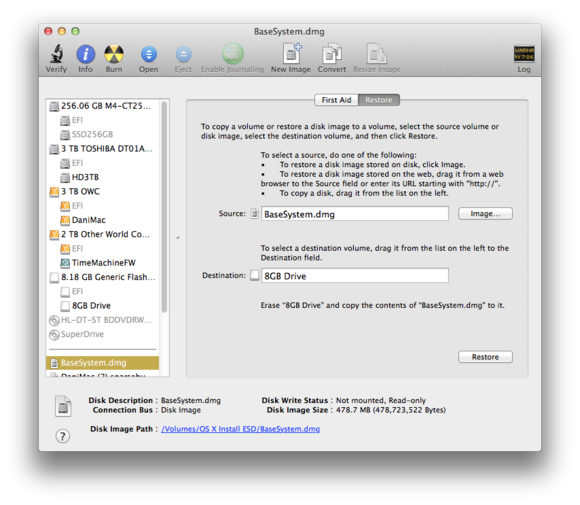
As soon as you hear the startup chime press and hold the option key on your keyboard.

Installation Instructions:Insert the USB in your USB Slot. Please be patient and allow the process plenty of time to finish.

Yosemite bootable usb for mac install#
If you like, you can rename the drive from OS X Base System to something more descriptive, such as Yosemite Installer.This USB can be used to install a clean copy of Apple Mac OS X Yosemite 10.10 or to update your existing system to Mac OS X Yosemite 10.10 Installing, Recovering or upgrading your software from a USB is NOT a quick process and can take 30-45 minutes to complete. You now have a bootable Yosemite install drive. Open the Terminal app, type (or copy and paste) the following command, and then press Return:ĭefaults write AppleShowAllFiles 0 & killall Finder You’ll likely want to re-hide invisible files in the Finder. Copy these files to the root (top) level of your install drive (OS X Base System, not into the System or Installation folder). (You're replacing the deleted Packages alias with this Packages folder.) The folder is about 4.6GB in size, so the copy will take a bit of time, especially if you’re copying to a slow thumb drive.ġ5) Also in the mounted OS X Install ESD volume, you’ll find files named BaseSystem.chunklist and BaseSystem.dmg. Drag that folder into the Installation folder on your destination drive. Delete that alias.ġ4) Open the mounted OS X Install ESD volume, and you’ll see a folder called Packages. Inside that drive, open the System folder, and then open the Installation folder. Click Restore, and then click Erase in the dialog box that appears if prompted, enter an admin-level username and password.ġ2) Wait for the restore procedure to finish, which should take just a few minutes.ġ3) Open the destination drive-the one you’re using for your bootable installer drive, which has been renamed OS X Base System. (If the destination drive has additional partitions, just drag the partition you want to use as your bootable installer volume.)ġ1) Warning: This step will erase the destination drive or partition, so make sure that it doesn’t contain any valuable data. Drag the latter-the one with the drive name-into the Destination field on the right. You may see a couple partitions under the drive: one named EFI and another with the name you see for the drive in the Finder.
Yosemite bootable usb for mac mac#
(This tells the Finder to show hidden files-we’ll re-hide such files later.)Ħ) Launch Disk Utility (in /Applications/Utilities) and then drag BaseSystem.dmg (in the OS X Install ESD volume) into Disk Utility’s left-hand sidebar.ħ) Select BaseSystem.dmg in Disk Utility’s sidebar, and then click the Restore button in the main part of the window.Ĩ) Drag the BaseSystem.dmg icon into the Source field on the right (if it isn’t already there).ĩ) Connect to your Mac the properly formatted hard drive or flash drive you want to use for your bootable Yosemite installer.ġ0) In Disk Utility, find this destination drive in the left sidebar. Open the Terminal app (in /Application/Utilities), then type (or copy and paste) the following command, and then press Return:ĭefaults write AppleShowAllFiles 1 & killall Finder That volume will appear in the Finder as OS X Install ESD open it to view its contents.ĥ) Several of the files you’ll need to work with are hidden in the Finder, and you need to make them visible. It’s called Install OS X Yosemite.app and it should have been downloaded to your main Applications folder (/Applications).Ģ) Right-click (or Control+click) the installer, and choose Show Package Contents from the resulting contextual menu.ģ) In the folder that appears, open Contents, then open Shared Support you’ll see a disk image file called InstallESD.dmg.Ĥ) Double-click InstallESD.dmg in the Finder to mount its volume. Right-click (or Control+click) the Yosemite installer to view its contents.ġ) Once you’ve downloaded Yosemite, find the installer on your Mac. The procedure is a bit more involved with Yosemite than it was for Mavericks (which was itself a bit more involved than under Mountain Lion and Lion).

Here are the steps for using it to create your installer drive. You’ll find Disk Utility, a handy app that ships with OS X, in /Applications/Utilities. If you don't, you'll have to redownload the installer from the Mac App Store before you can create a bootable installer drive. If you plan to use that installer on other Macs, or-in this case-to create a bootable drive, be sure to copy the installer to another drive, or at least move it out of the Applications folder, before you install.

As with the Mavericks installer, if you leave the Yosemite beta installer in its default location (in the main Applications folder) when you install OS X 10.10, the installer will delete itself after the installation finishes. Like all recent versions of OS X, Yosemite is distributed through the Mac App Store.


 0 kommentar(er)
0 kommentar(er)
